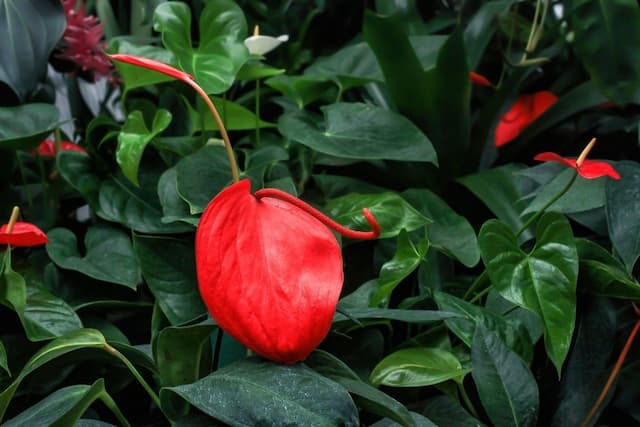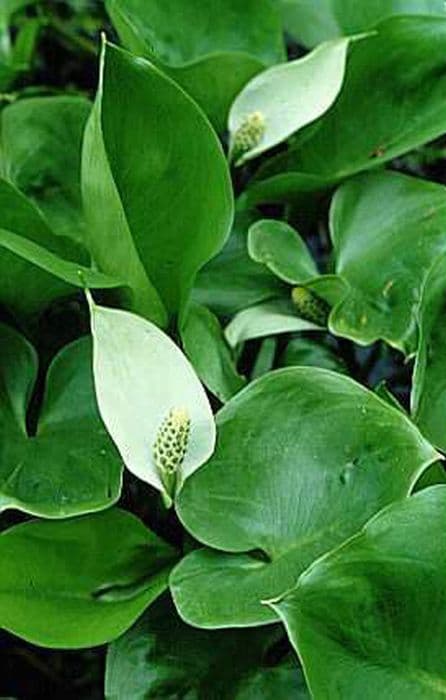Calla Lily 'Purple Moon' Zantedeschia 'Purple Moon'

ABOUT
The Zantedeschia 'Purple Moon', commonly known as the Calla Lily, boasts an elegant and striking appearance. This particular variety is prized for its deep purple-hued flowers that resemble a trumpet or a fluted cup. The blooms are characterized by a smooth, waxy finish and gracefully curl at the edges, creating a sensuous display of color and form. A prominent yellow spadix, which is the flower's reproductive organ, emerges from the center of the bloom, adding a contrasting pop of color. The foliage of the Purple Moon Calla Lily is lush and glossy, often dark green in color with a slightly arrowhead-like or lance-shaped appearance. The leaves can display spots or streaks, which provide interesting visual texture beneath the showy blossoms. The plant gives off an air of sophistication and drama, making it a popular choice for ornamental purposes in gardens and floral arrangements.
About this plant
 Names
NamesFamily
Araceae
Synonyms
Calla Lily, Arum Lily, Purple Moon Calla Lily
Common names
Zantedeschia 'Purple Moon'
 Toxicity
ToxicityTo humans
The calla lily, including the 'Purple Moon' variety, is toxic to humans if ingested due to the presence of calcium oxalate crystals. The symptoms of poisoning include a burning sensation in the mouth and throat, difficulty swallowing, nausea, vomiting, and diarrhea. In severe cases, it can cause swelling of the tongue and throat, which can lead to difficulty breathing. Contact with the sap may also cause skin irritation.
To pets
The calla lily is also toxic to pets for the same reasons it is to humans. If a pet ingests any part of the plant, they may experience symptoms such as oral irritation, pawing at the mouth, excessive drooling, vomiting, difficulty swallowing, and in severe cases, difficulty breathing due to swelling of the throat. Immediate veterinary attention is recommended if a pet ingests this plant.
 Characteristics
CharacteristicsLife cycle
Perennials
Foliage type
Deciduous
Color of leaves
Varies
Flower color
Purple
Height
2 feet (0.6 meters)
Spread
1 foot (0.3 meters)
Plant type
Herb
Hardiness zones
9
Native area
Africa
Benefits
 General Benefits
General Benefits- Ornamental Value: Zantedeschia 'Purple Moon', commonly known as Calla Lily, offers striking purple-hued blooms that enhance the aesthetic appeal of gardens and indoor arrangements.
- Easy to Care For: This plant is relatively low-maintenance, requiring minimal attention once established in the right conditions.
- Long Blooming Period: The Calla Lily has a lengthy blooming season, providing colorful displays for extended periods.
- Attracts Pollinators: It can attract beneficial pollinators like bees and butterflies, contributing to the health of your garden ecosystem.
- Versatile Planting Options: Suitable for both garden beds and containers, it offers flexibility for gardeners with limited space.
- Drought Tolerance: Once established, Calla Lilies are fairly drought-tolerant, making them suitable for dry climate gardens.
- Impactful Cut Flowers: They make for elegant and long-lasting cut flowers in bouquets and floral arrangements.
 Medical Properties
Medical PropertiesThis plant is not used for medical purposes.
 Air-purifying Qualities
Air-purifying QualitiesThis plant is not specifically known for air purifying qualities.
 Other Uses
Other Uses- Zantedeschia 'Purple Moon', commonly known as calla lily, can be used as a natural dye due to the rich pigmentation in its flowers, which can impart color to fabrics and crafts.
- Calla lilies can be used in art classes for botanical illustration practice, as their unique form and vibrant color provide a challenging and interesting subject for artists.
- As a photography subject, calla lilies, particularly the 'Purple Moon' variety, are sought after by photographers for their striking appearance and can be used in portfolios and photography contests.
- The spathes of calla lilies can be used as eco-friendly confetti or decorative elements in eco-conscious events to reduce plastic waste.
- Due to their striking and sturdy stalks, calla lilies can be incorporated into jewelry design, such as in the crafting of floral-themed eco-resin pendants and earrings.
- Calla lilies can be used as inspiration for interior design, influencing color schemes and patterns in home décor with their deep purple hues.
- The 'Purple Moon' calla lily can serve as a model for floral motifs in fashion design, influencing textile patterns and accessory styles.
- These flowers can be utilized in culinary presentations as an edible garnish, after ensuring they are free of pesticides and properly cleaned.
- The silhouette of the calla lily can be used in graphic design and branding, representing elegance and beauty in logos and marketing materials.
- Calla lilies can be part of educational horticultural programs, where participants learn about hybridization and cultivating ornamental plants.
Interesting Facts
 Feng Shui
Feng ShuiCalla Lily is not used in Feng Shui practice.
 Zodiac Sign Compitability
Zodiac Sign CompitabilityCalla Lily is not used in astrology practice.
 Plant Symbolism
Plant Symbolism- Royalty and Elegance: The 'Purple Moon' Calla Lily's rich purple color is often associated with royalty and nobility, conveying a sense of sophistication and elegance.
- Admiration and Beauty: Calla Lilies in general are linked to admiration and the breathtaking beauty of their unique flower form, making them emblematic of the beauty found in nature.
- Rebirth and Resurrection: The 'Purple Moon' Calla Lily, with its trumpet-like flowers, is commonly associated with rebirth and resurrection, a symbolism stemming from its association with the Easter season in Christianity.
- Mystery and Passion: Dark purple hues are often connected to mystery and passion, and the 'Purple Moon' Calla Lily can represent deep emotions and intrigue.
- Commitment and Devotion: Due to their frequent use in wedding ceremonies, Calla Lilies symbolize true devotion and long-term commitment between partners.
 Water
WaterFor Calla Lily 'Purple Moon', it is best to water when the top inch of the soil feels dry to the touch, which typically means watering once a week. These plants prefer consistently moist soil, so regular checks will ensure they are neither over nor under-watered. Depending on the size of the pot and the indoor conditions, you may use about a pint of water each time. During the active growing season in spring and summer, you may find the need to water slightly more frequently. In winter, reduce watering slightly to allow for the plant's dormant period.
 Light
LightCalla Lily 'Purple Moon' thrives in bright, indirect light. A north-facing or east-facing window is ideal, where the plant can receive plenty of light without being exposed to harsh direct sunlight. However, a little morning sunlight can be beneficial, just avoid the intense afternoon sun which can scorch the leaves.
 Temperature
TemperatureThe ideal temperature range for Calla Lily 'Purple Moon' is between 60 to 75 degrees Fahrenheit. They can survive short periods outside this range but should never be exposed to temperatures below 50 degrees Fahrenheit or above 80 degrees Fahrenheit, as extreme temperatures can damage the plant.
 Pruning
PruningPruning Calla Lily 'Purple Moon' is mainly done to remove spent flowers and yellow or brown leaves, which encourages new growth and improves the plant's appearance. Pruning can be done as needed throughout the growing season; however, the best time is after blooming when you can cut back the flower stems to the base. This helps the plant to save energy for the next flowering cycle.
 Cleaning
CleaningAs needed
 Soil
SoilCalla Lily 'Purple Moon' thrives in a well-draining, fertile potting mix with a pH of around 6.0-6.5. A mixture of loam, peat, and perlite or sand is ideal for this plant.
 Repotting
RepottingCalla Lilies should generally be repotted every two years to refresh the soil and provide room for growth.
 Humidity & Misting
Humidity & MistingCalla Lily 'Purple Moon' prefers high humidity levels, ideally between 60-70% for optimal growth.
 Suitable locations
Suitable locationsIndoor
Provide bright, indirect light and keep soil moist for indoor Calla Lilies.
Outdoor
Plant in partial shade, shelter from strong winds, and keep soil moist.
Hardiness zone
8-10 USDA
 Life cycle
Life cycleThe Zantedeschia 'Purple Moon', commonly known as a purple calla lily, starts its life cycle as a rhizome, which is a type of underground stem that stores energy for the plant. When conditions are favorable, typically in early spring, the rhizome sprouts and produces shoots, which grow into lush foliage and the characteristic funnel-shaped purple flowers. After flowering, which can last several weeks, the plant enters a period of pollination, often with the help of insects, and may produce seeds if the flowers are successfully pollinated. Following the flowering stage, the calla lily enters a period of senescence in late summer to autumn; the leaves yellow and die back as the plant begins to go dormant. During dormancy, the plant conserves energy within the rhizome throughout the winter, until the cycle begins anew with the next growing season. If conditions are not ideal for growth, the rhizome can remain dormant underground for an extended period until favorable conditions return.
 Propogation
PropogationPropogation time
Spring-Early Summer
Zantedeschia 'Purple Moon', commonly known as a variety of Calla Lily, is generally propagated during its dormancy period, which falls in the late fall or early winter. The most popular method of propagation for Calla Lilies is by dividing their rhizomes. These underground structures store energy and can be separated to create new plants. When propagating, it is essential to use a sharp, sterile knife to divide the rhizomes into sections, ensuring that each section has at least one growth node or eye. After cutting, the sections can be left to dry for a day to let the cut areas callous over, reducing the risk of rotting. The individual rhizome sections can then be planted about 3 to 4 inches (approximately 7.6 to 10 centimeters) deep in well-draining soil with the eyes facing upwards. After replanting, water the soil thoroughly to help establish the new plants.









